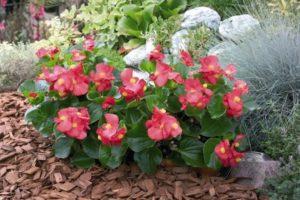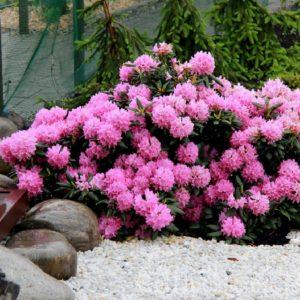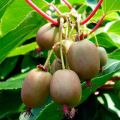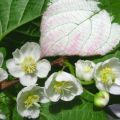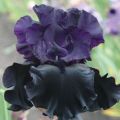Planting, growing and caring for wisteria in the open field, how to propagate
Wisterias are flowers that are used in landscape gardening compositions. They look spectacular because of the structural features and can decorate any site. The cultivation of wisteria is associated with adherence to the rules of care. In order for wisterias to please with their flowering, it is necessary to choose the right places for their placement, as well as control their growth.
General information about wisteria
Wisterias belong to the legume family. They are profuse flowering climbing plants of the liana type.
- The wisteria bush can grow up to 18-20 meters. A system of pinnate leaves is formed on it, they have a wedge-shaped shape and stretch up to 30 centimeters in length.
- Flowers are collected in brushes. Under the weight of small flowers, the inflorescences stretch downward, which reminds many of the jets of a rapid waterfall.
Wisteria flowers can be of different shades: pink-white and lilac varieties were bred by selection. Purple or light lilac petals are considered common.
Wild wisterias are found in the forested areas of the Chinese provinces. Cultivated hybrid types are grown in the south of Russia, in European countries with a moderately warm climate. In the United States, wisteria began to be grown as indoor plants. In this case, the tree is formed in the common bonsai style, leaving the woody trunk bare.
Varieties and varieties
Wisteria became widespread after varieties adapted to different conditions were artificially bred from wild species.
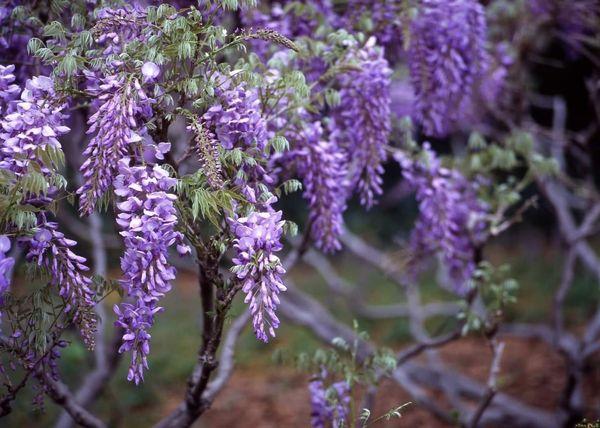
Among the 9 officially existing species, only 3 are especially popular.
- Chinese wisteria. Liana of this variety reaches 25 meters, the shoots twist inward. At the stage of ovary formation, a fine white edge appears on the leaves, then it disappears. The leaves grow up to 20-30 centimeters, they are narrow, unpaired. Inflorescences form at the tops or apical depressions. The colors range from white to lilac. Flowers are small, can grow up to 2.5 centimeters. The growing season takes about 150 days. The species blooms from May to August.
- Abundant flowering or Japanese wisteria. This variety begins to bloom in March, the inflorescences can stretch up to 80 centimeters. Some hybrids can have red and yellow petals.This type is considered especially spectacular, it is the Japanese wisteria that is customary to decorate arches in parks and gardens.
- Shrub or American wisteria. A more compact variety. Inflorescences grow up to 15 centimeters. It looks like an acacia, sometimes they are confused. Among the shrub varieties, the Macrostachia Blue Moon (Blue Moon) variety is especially popular. The variety was bred in America. A married couple living in the northern state have worked for several years to create a frost-resistant variety. They managed to create a hybrid that can withstand freezing temperatures down to -20 degrees.
- Indoor or home wisteria. These are small trees that form in the bonsai style. At home, flowers feel comfortable when planted in a large pot.
The specifics of growing flowers
Wisterias, due to the peculiarities of growth and structure, have special requirements for maintenance and care. Growing in the Middle Lane is possible only if additional conditions are created. In addition, wisteria must be properly cared for.

Soil requirements
The characteristics of soil suitable for growing wisteria consist of 3 points. The soil should be light, loose and nutritious. To achieve these values, you need to check the acidity of the soil. Slightly acidic soils are suitable for planting, in which the lime content is minimized. Clay soils with a maximum range of nutrients are the best option for plants.
Choosing a location
Wisterias are thermophilic flowers. The homeland of wild species is the humid tropics, therefore, warm regions are needed for full growth and development of the remaining hybrid varieties.
To choose a landing site, you need to be guided by the following rules:
- the site is chosen from the south side;
- the ideal option are places protected from through winds;
- sunlight must reach the plants for at least 10 hours;
- it is necessary to take into account the tendency of the species to grow;
- vines need special supports; pre-installed trellises are a good option.
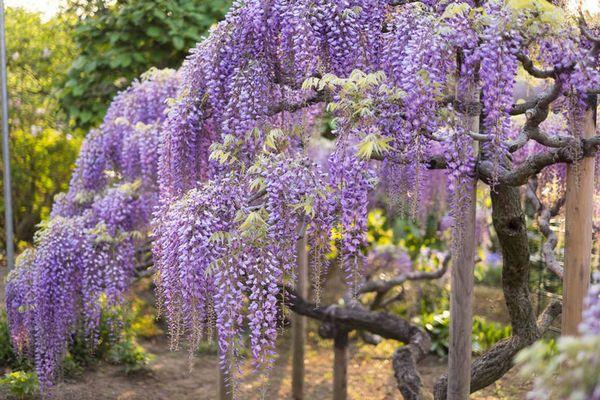
How and when to plant
The period when flowers are planted in open ground should exclude the possibility of recurrent frosts. Despite the fact that hybrid varieties are frost-resistant, after transplanting they can freeze during the adaptation phase. Seedlings are planted in deep holes 50 by 50 centimeters in size. Prepared drainage is placed on the bottom of the hole. In addition, mineral fertilizers are applied during planting.
Information! After planting, wisteria can reduce the growth rate. This means that the root system of the flower is adapting to new growth conditions.
Further care of the culture
After planting, a crucial period begins, which determines the future of the flower. Care is associated with specific features.
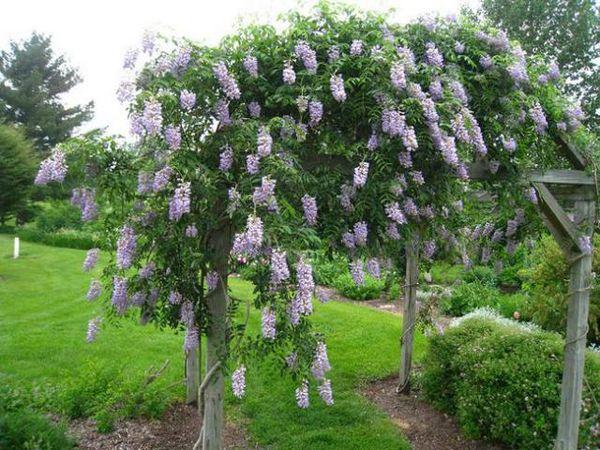
Fertilizing and feeding wisteria
Like any abundantly flowering plant, wisteria spends energy on the formation of inflorescences and long flowering. Therefore, feeding is an important part of grooming. They are carried out in accordance with some rules:
- At the stage of active formation of green mass, plants need to be supplemented with mineral and organic fertilizing. They are brought in 1 time in 7 days, alternating with each other.
- 1-2 times during flowering, the plants are watered with chalk water.
- The term for the first top dressing is March.
Watering
Irrigation should be regular throughout the spring and summer. Watering is carried out as the soil dries. The soil should be constantly moist, and excessive moisture should be avoided. Stagnant moisture leads to root rot, which is manifested by a drop in color and a change in the shades of the leaf plates.
Air humidity
It is difficult to control humidity in a garden plot, so growers resort to some tricks. Wisterias don't like dry air. During a dry summer, artificial irrigation ditches are turned on next to the vines.At the same time, make sure that moisture is sprayed not on the vines, but next to them.

Temperature regime
For flowering wisteria, an average air temperature of at least +20 degrees is required.
The frost-resistant variety is capable of surviving severe frosts, but in low temperatures it simply will not bloom.
Pruning
This is an important step during the growth of the plant. The continued existence of the variety depends on the correct pruning.
The first pruning takes place in early spring. Subject to removal:
- dead branches;
- old shoots;
- overgrown branches that interfere with formation.
When flowering, faded brushes are immediately removed so that they do not interfere with the further process.
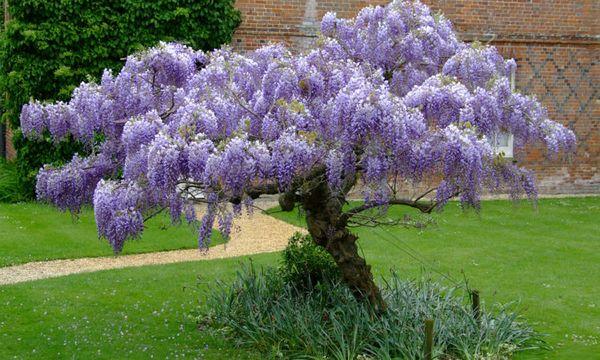
How to shelter for the winter
In Siberia, the Leningrad Region and the Moscow Region, wisteria need additional shelter for the winter. Preparations begin in late autumn. Lianas are removed from the supports, the non-viable parts are cut off. Lianas are carefully laid on the ground in the direction of growth. Then they are covered with a layer of coniferous branches, sawdust or agrofibre. A thin layer of prepared soil is poured onto the shelter. Thus, the plant will be protected from frost. The additional layer will be snow cover.
Treatment against diseases and pests
The species deficiency of wisteria lies in its instability to diseases and pests. This poses a particular danger, because flower growers recommend preparing vines in advance.
After planting in the spring, the plants are sprayed with special chemicals.
- A step-by-step treatment is carried out for aphids and ticks.
- The soil is supplemented with mineral complexes that can stop the development of fungal infections.
Features of growing in the regions
In the south of the country, wisteria grows without additional conditions. In the north, vines are sheltered for the winter. In addition, in Siberia or the Urals, vines are fed with organic fertilizers 2 times more than in other regions of the country. Those varieties are grown there that have increased winter hardiness.
Reproduction methods
Different methods are used to breed varieties. Choose the one that suits the best, depending on the climatic conditions.
Layers
Structural features allow you to breed wisteria by layering. This method is suitable for creeping, climbing varieties. Liana is buried in the ground, evenly distributing it along a previously prepared groove. The layers are left for rooting. The next season, they are separated from the mother tree and transplanted to a new location. The method preserves the varietal characteristics of wisteria.
Lignified cuttings
One way to propagate wisteria involves separating young cuttings and rooting in water or soil. For cuttings, a shoot with a length of at least 15 centimeters is chosen, then powdered with a biostimulant for root growth and rooted by water or soil. Rooting, as a rule, is carried out before winter in order to plant prepared seedlings in the spring.
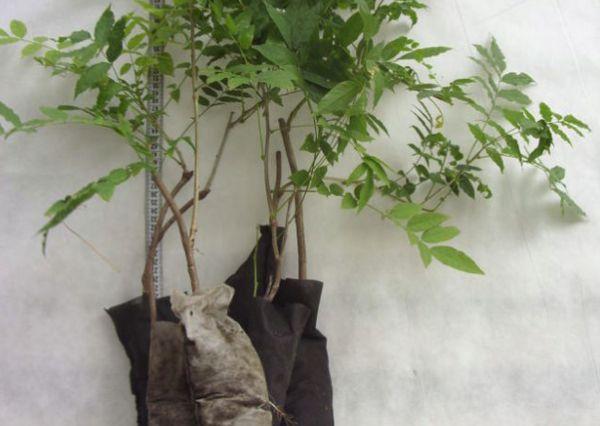
Winter root grafting
It is also possible to propagate wisteria by grafting. The goal is to develop a new variety. For this, varietal and non-varietal types are used. Roots that have reached 6 millimeters are dug up in the fall.
Then they are rooted separately for several months. Rooted cuttings of the off-grade type are combined with the same cuttings of the selected variety. They are tied to each other with adhesive tape, treated with fungicides and released into a container with soil for further joint rooting.
In the spring, the seedling will be ready for planting in a permanent place of growth, provided more than 10 new leaves appear. If there are fewer leaves in the axils, then the shoot is harvested for growing. Heated greenhouses are suitable for this.
From seed
Wisteria seeds are purchased in specialized stores. They are sown in autumn in containers with low sides.The seeds are buried 2 centimeters, then sprinkled with the remaining soil. Before emergence, the topsoil is sprayed with a spray bottle. For growth, it is necessary to maintain a temperature regime from +23 to +25 degrees.
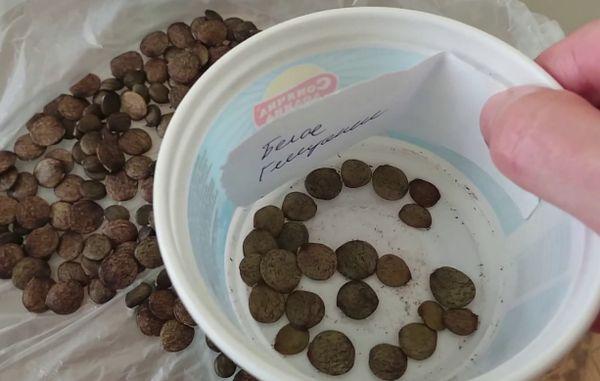
Seedlings of wisteria are grown in the classical way, before planting in open ground, they begin special training. The containers are removed to fresh air to harden the seedlings and reduce the effects of planting stress.
Landscape design
To decorate the landscape, wisterias are suitable:
- when decorating arched compositions;
- for decorating gazebos, balconies;
- as part of a hedge.
A prerequisite for the growth of wisteria is the use of additional supports, which allow the vines not only to grow upward, but also to grow in width.
